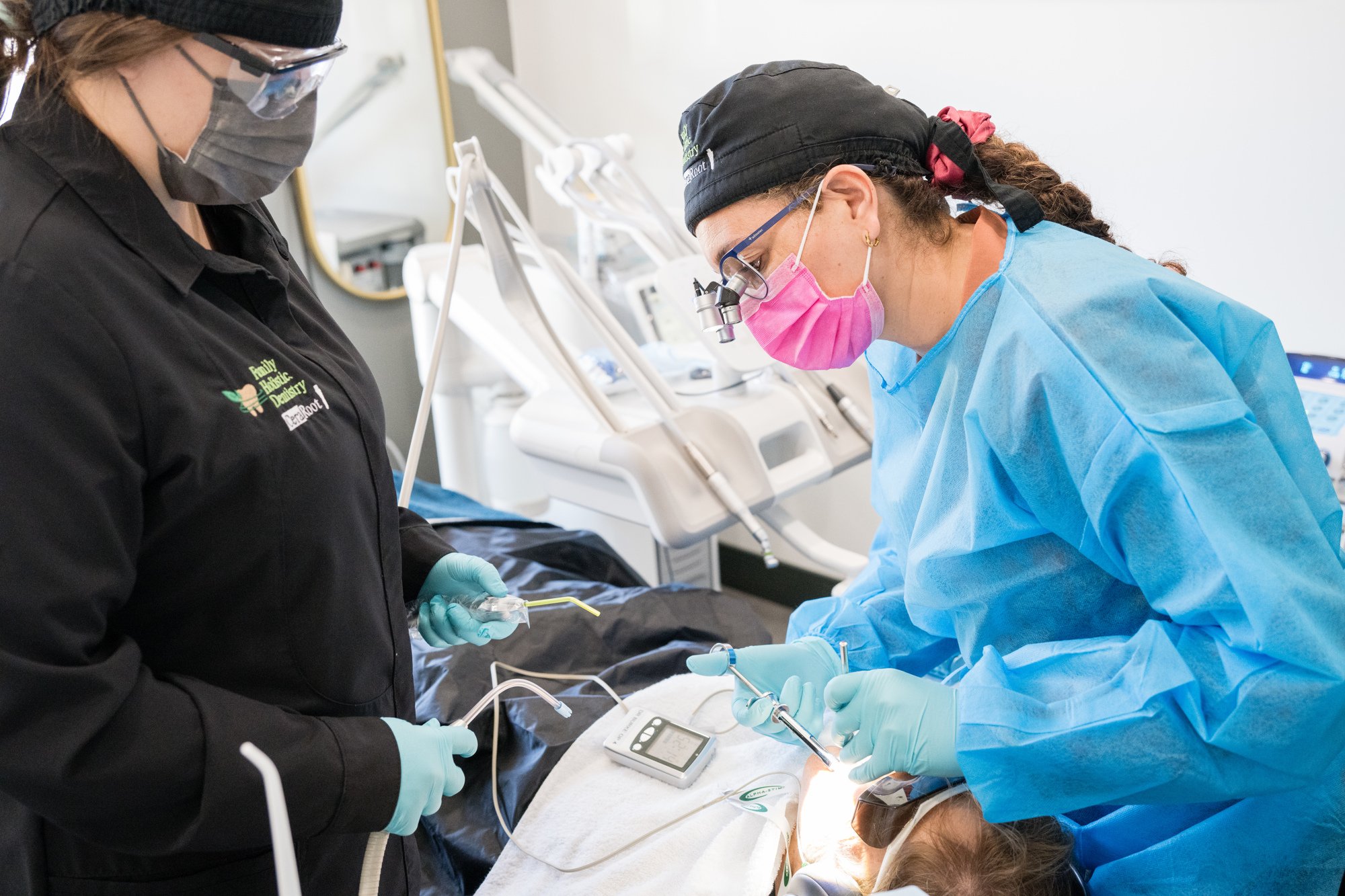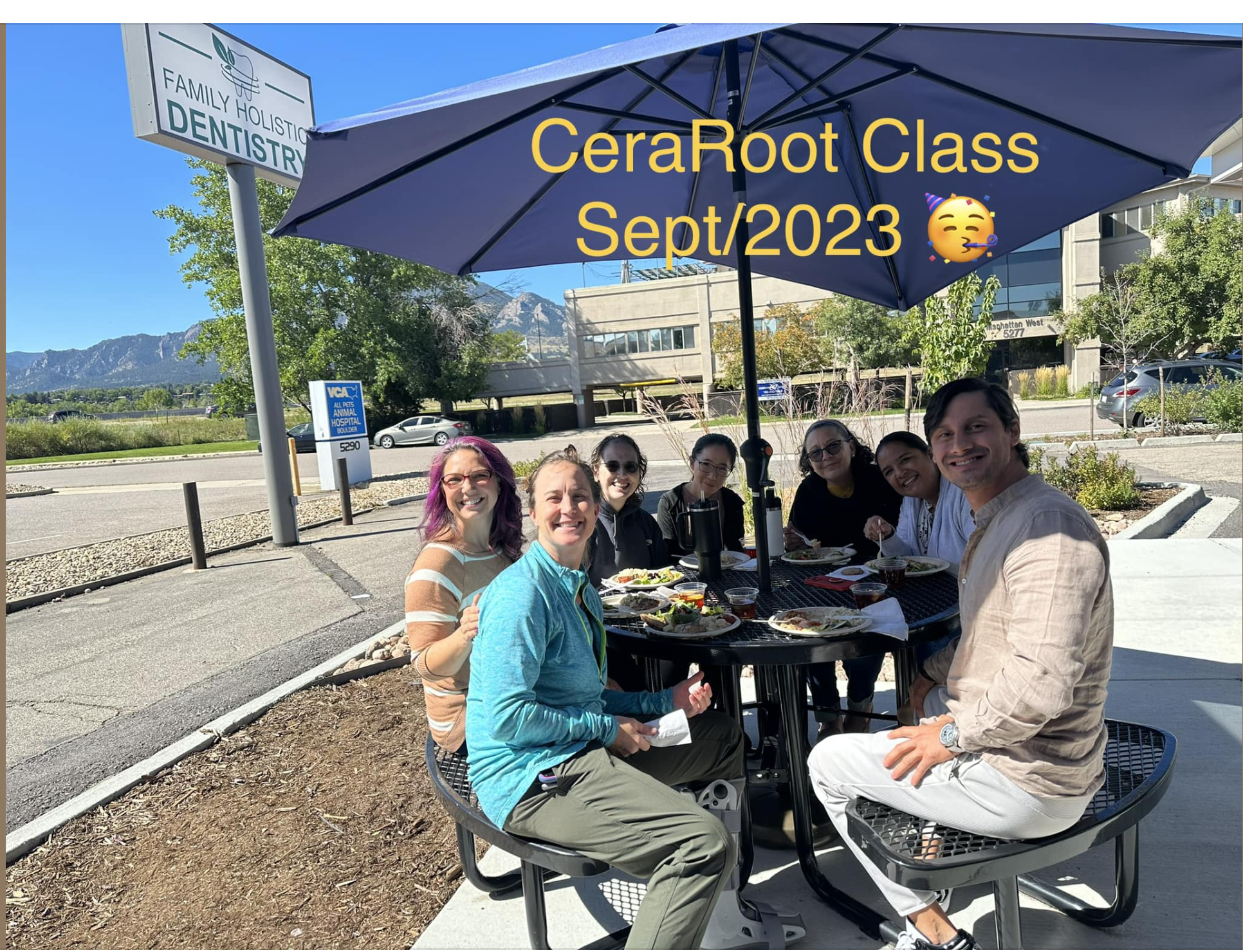
Ceramic Implants
We place metal-free CeraRoot ceramic implants made from zirconia, a biocompatible ceramic material that fosters complete assimilation into the jaw bone.
Zirconia is a biocompatible material that is resistant to chemical corrosion. It will not conduct electricity or heat. As a bioinert material, it will never trigger chemical reactions, migrate to other sites in the body, or interfere with the maintenance of optimal oral health.
The fact that zirconia does not conduct an electrical charge is a big benefit. Bacterial growth on the surface of a zirconia implant is far less likely to adhere due to its non-conductivity, thus creating an oral environment that promotes much healthier gums.
CeraRoot zirconia implants are hypoallergenic. This is important because there are growing number of people with chemical sensitivities and compromised immune systems.
“I have placed ceramic implants for four years, and if the conditions are right, we can place them at the time of extraction.
When we do the immediate implant procedure, we are committed to thoroughly cleaning out any infection and removing the periodontal ligament, regardless of how long the process may take. To achieve optimal results, we use a protocol of piezosurgery, ozone, laser, and PRF. If a bone graft is necessary, we choose between Cerasorb, a beta-tricalcium phosphate synthetic graft from @Curasan, or autogenous grafts from the patient's donor site. Our practice does not use cadaver bone grafts from human or animal sources. You can visit our YouTube channel for testimonials and our service page on extractions for more information.”
About Dr. Burke
Dr. Carmen Burke has done dental school twice, in Colombia (1998) and Loma Linda University Dental School in California (2016). She is on the perio committee of the IAOMT and is a certified CeraRoot instructor. She has placed close to 500 ceramic implants. In addition, she teaches other dentists a course on one-piece CeraRoot implant placement in conjunction with her holistic protocol with the CEO of CeraRoot, Dr. Xavi Oliva.
Testimonial: Full Mouth Rehab:
The patient had numerous missing teeth due to long-term bite issues. We fixed the bite and used various CeraRoot ceramic implants to rehabilitate his mouth.
"For the first time in two decades, I have a full mouth of teeth.”
“It has been a very successful and credible job done carefully. The pain has been minimal and always managed with care quadrant by quadrant.”
A recent microscopic study performed at the University of Minnesota confirmed optimal osseointegration of CeraRoot implants without any signs of inflammation or foreign body rejection. Other scientists have also reported that zirconia is ideal for dental implants.
Since zirconia is non-metallic and white, it is natural-looking. It’s a perfect base color that closely mimics what nature created. Patients with thin, translucent gums or those prone to gum recession (such as many aging people) may benefit esthetically from it.
One-piece ceramic implants are designed for the immediate placement after tooth extractions. This one-stage surgical approach minimizes implantation time and maximizes comfort.
Testimonial:
Ceramic Implant Placement
“The front tooth is amazing, and it's beautiful.”
Our patient said that an infected root canal tooth was causing her severe pain in her face and nose, as well as bad headaches. She felt much better once the tooth was extracted and the ceramic implant was placed. She started healing and says she has a lot more energy. You can see more testimonials on our YouTube Channel.
“The teeth adjacent to the missing tooth must be prepared or reshaped to support the bridge.”
On the other hand, the implant is a one-tooth problem, one-tooth solution.
When a missing tooth is not replaced, the alveolar bone is reabsorbed, which affects the bone around the adjacent teeth. The implant helps keep the bone for the adjacent teeth.
Some Frequently Asked Questions
-
If you are healthy enough to have a tooth extracted, you are probably healthy enough to have an implant. General good health and adequate bone in the jaw are the key requirements. Some medical factors might prevent a person from being a good candidate for dental implants. Some of these may be uncontrolled diabetes, chemotherapy or radiation therapy, parathyroid disorders, blood disorders, rare bone disorders, or bone marrow cancer. Some physical factors may include insufficient or poor-quality bone, low sinuses, or nerve bundles.
-
The success of your implants will depend greatly on how well you maintain them. They should be professionally cleaned by a hygienist and examined by your implant dentist at least every 6 months. This hygienist should be trained in the specific procedure of maintaining dental implants. Also, brushing daily is absolutely necessary for long-term success.
-
In our office, a healed-site implant will take 90 minutes, and an extraction and implant will take two and a half hours. Part of that is because we use PRF and have to draw your blood. We use red light therapy to promote vascularization.
-
Long-term success depends on multiple factors. First off, success will depend on the quality and quantity of bone. The better the bone and the more available, the greater the chance of long-term success. Secondly, the experience and ability of the dental surgeon will be a factor. As with any surgical procedure, there is no substitute for the experience and individual talent of the dentist. Third, the restoration quality placed on the implant will play a big role in long-term success. If the design of the implant crowns or overdentures are poorly constructed, and biting forces are not balanced, even the best-placed dental implant will have a compromised survival rate. Finally, like natural teeth, implants need to be checked and maintained regularly by your dentist.
-
When you lose your teeth, you gradually lose the bone that supports them. As this bone disappears, problems with other teeth nearby and a lack of support for dentures, partials, and bridges increase. These could include pain, mobility, lack of prosthetic retention, sharp, painful ridges, mobile gum tissue, and sore spots. The tongue enlarges to accommodate spaces for missing teeth. With tooth loss, a five-fold decrease in function occurs, and the diet shifts to softer foods. Also, when a bone is lost, numbness to the lower lip or even the possibility of a jaw fracture rises. Since the bone is deteriorating, it will spread and deteriorate around healthy teeth and ultimately cause the loss of those teeth like the “domino effect.”
-
An implant is a man-made replacement for natural teeth, allowing the person to return to fixed teeth. It is not a transplant, which is taken from another person. There are several categories of dental implants, which will be selected by the doctor depending on your specific needs and general dental condition. Traditionally, implants have been made out of titanium. The latest research and investigation have demonstrated better biocompatibility of zirconium oxide, and many dentists worldwide offer them to their patients.
-
The body does not reject a dental implant, as it might, a soft tissue transplant, such as a lung, heart, or kidney. This does not mean an implant cannot fail, but it would be due to other factors, such as misalignment, improper force on the implant, or other conditions or existing diseases of the patient. Zirconium oxide is biocompatible, integrates with the surrounding bone, and becomes part of the body. Zirconium oxide is also used in orthopedics to replace hip, finger, and toe joints.
-
It depends on many factors:
1-Pain threshold: if your pain threshold is high, you can return to work the next day. However, we recommend resting the day of the procedure and the day after to set the starting point of the healing.
2- Type of Job: If your job is indoors in an office, you resume activities the next day. On the other hand, if your job is outdoors, it is better to rest for two more days.
3. Work activities: Take 2 more days if you require dexterous movements such as lifting heavy objects, teaching aerobics, going up and down, constructing, plumbing, etc.
You can resume the next day if you work in an office.
We recommend resting since doing so is therapeutic and placing ice inside and outside your mouth for 2 days. On the third day, we recommend moist heat ( 3 cups of hot water, 1 TBS of Epson salt, washcloth). This will help improve vascularization.
-
Anyone missing one or more (even all) of their teeth may be a candidate for implants. If one or a few teeth are missing, implants, in conjunction with a crown or bridge, can replace those teeth and function as normal teeth without losing more bone and being subject to decay. If all or most of your teeth are missing, implants may be placed to fix a full-mouth denture.
-
Minors who have not finished all their growth must not receive implants because this could interfere with the jaws' growth process.
Post Operative Questions
-
Take ibuprofen (400-800 mg) and Tylenol (600-1,000 mg) every six hours as needed. Do not exceed the daily limits of 3,200 mg ibuprofen and 4,000 mg Tylenol.
-
Antibiotics are given to prevent infections that could spread to the brain or heart. They are taken two days before surgery and continued for about 10 days. We don’t want you get to sepsis.
-
Avoid rinsing, swishing, and using toothpaste for four weeks. Use a surgical toothbrush that we provide that is dipped into to water to gently clean adjacent teeth, and avoid electrical toothbrushes. Also, please brush the opposite arch with essix in place. And remember to use dental floss in the entire mouth.
-
Smoking and vaping reduce blood flow, hinder healing, and increase the risk of implant failure and infection.
-
No, avoid blowing your nose for six weeks to prevent disrupting the sinus membrane, which needs time to heal. If you have to sneeze don’t hold you sneeze but try to do it gently
-
Follow-ups occur at one week, one month, two months, and three months to monitor healing, adjust the Essix retainer when needed and guide you accordingly, and determine when can get your implant crown.
-
Apply an ice pack to the cheek on the affected side for 20 minutes every hour during the first 48 hours. Sleep with your head elevated using two pillows. If your teeth sensitive allows, keep crushed ice inside the mouth for some period of time during those 48 hours.
-
Avoid heavy lifting and intense cardio for at least one week. Light walking is acceptable, but listen to your body and stop if it feels too strenuous.
-
Eat soft foods such as mashed potatoes, steamed vegetables, soups, and soft bread (without crust). Avoid hard, sticky, crunchy foods, and anything with seeds.
-
Using a straw creates negative pressure, which can dislodge the PRF and blood clot, potentially leading to dry socket and delayed healing.
-
Wear it 24/7 for the first three days, don’t take it out for any reason. Starting the fourth day, continue to wear it 24/7 but take it out to rinse after each meal. After you eat put it back. After eating is the only time you take the Essix out to rinse. Make sure you eat and sleep with the Essix. You do this to prevent micro-movements that could disrupt osseointegration (bone healing around the implant).
-
Begin using moist heat 48 hours after surgery. Soak a washcloth in hot water with Epsom salt, wring out excess water, and apply it to the affected cheek until it cools. Becareful not to burn your skin.







